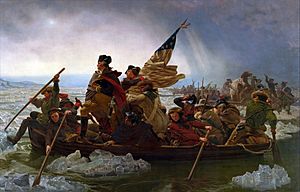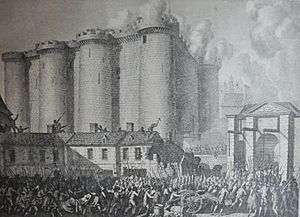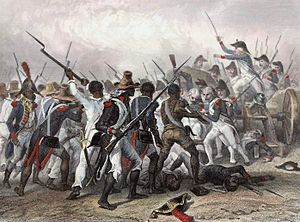Age of Revolution facts for kids
| Part of the Age of Enlightenment | |
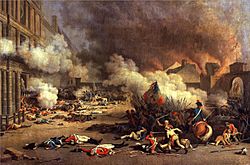
Scene from the French Revolution: The storming of the Tuileries, August 1793
|
|
| Date | 22 March 1765 – 4 October 1849 |
|---|---|
| Outcome | Industrial Revolution Multiple revolutionary waves Atlantic Revolutions Latin American wars of independence Revolutions of 1820 Revolutions of 1830 Revolutions of 1848 End of feudalism Widespread implementation of Republicanism |
| Deaths | American Revolution: 37,324+
French Revolution: 150,000+ Napoleonic Wars: 3,500,000–7,000,000 (see Napoleonic Wars casualties) Over 3,687,324–7,187,324 casualties (other wars excluded) |
The Age of Revolution was a time of big changes from the late 1700s to the mid-1800s. During this period, many important revolutions happened across Europe and the Americas. This era is known for countries moving away from kings with total power. Instead, they started having governments where people were represented. These new governments often had a written constitution. This time also saw the creation of new nation states.
New ideas from the Enlightenment greatly influenced these changes. The American Revolution (1765–1783) is often seen as the start of this age. It then inspired the French Revolution of 1789. The French Revolution quickly spread its ideas through wars across Europe. In 1799, Napoleon took control in France. He continued the French Revolutionary Wars by conquering much of Europe. Napoleon brought new ideas like equality before the law to the lands he conquered. He also introduced a civil code. However, his strict military rule led to people fighting back. This happened especially in Spain and Germany.
After Napoleon's defeat, European powers formed the Holy Alliance. This happened at the Congress of Vienna in 1814–15. They tried to stop future revolutions and brought back old monarchies. But Spain was weakened by the wars. It could not control its American colonies. Almost all of them declared independence between 1810 and 1820. Revolutions then spread to southern Europe in 1820. There were uprisings in Portugal, Spain, Italy, and Greece. Europe saw two more big waves of revolution in 1830 and 1848. These are also called the Spring of Nations. People wanted more democracy and often wanted their own independent nations. This happened in places like Italy and Germany. The harsh stopping of the Spring of Nations marked the end of this revolutionary era.
The term "Age of Revolution" became popular because of the British historian Eric Hobsbawm. He used it in his book The Age of Revolution: Europe 1789–1848, published in 1962.
Contents
- What Was the Industrial Revolution?
- The American Revolution (1765–1783)
- The French Revolution (1789–1799)
- The Haitian Revolution (1791–1804)
- The United Irishmen's Rebellion (1798)
- The Serbian Revolution (1804–1835)
- The Latin American Wars of Independence (1808–1833)
- The Greek War of Independence (1821–1832)
- The Revolutions of 1820
- The Revolutions of 1830
- The Revolutions of 1848
- The Eureka Rebellion (1854)
- The First War of Indian Independence (1857–1858)
- The Bulgarian Revolts and Liberation (1869–1878)
- See also
What Was the Industrial Revolution?
The Industrial Revolution was a time when new ways of making things appeared. This happened from about 1760 to between 1820 and 1840. It was a huge turning point in history. Almost every part of daily life changed. People's average income and the population started to grow faster than ever before. This led to cities growing very quickly. This fast growth caused social problems and unrest. For example, money problems from industrialization helped cause later revolutions, like those in 1848. New social groups also appeared. Some of these groups started to disagree with traditional politics. The rise of the city middle class shows this. They became a powerful group that needed to be part of the political system. These big changes also led to new political ideas. These ideas were against the old ways of life before factories. The start of the Industrial Revolution is also seen as a key point for climate change.
The American Revolution (1765–1783)
The American Revolution gave independence to the Thirteen Colonies of British America. This was the first European colony to become independent. It led to the creation of the United States of America. This new country wrote and approved a U.S. Constitution. This document had many new ideas for a republic with different parts of government. It included an elected leader and rules for property rights. It also protected rights like free speech, a free press, and religious freedom.
The French Revolution (1789–1799)
The British historian Eric Hobsbawm said the French Revolution shaped the ideas and politics of the 1800s. He noted that France gave the world its revolutionary ideas. For example, a tricolour flag became a symbol for many new nations. Politics between 1789 and 1917 were often about supporting or opposing the ideas of 1789. France also gave the world words and concepts for liberal and radical-democratic politics. It provided the first big example and idea of nationalism. France also offered models for law codes and scientific organization. The metric system of measurement came from France. The ideas of the modern world first reached old civilizations through French influence. This was all thanks to the French Revolution.
The French Revolution was a time of big social and political change in France. It lasted from 1789 to 1799. It deeply affected French and modern history. It marked the end of powerful kings and churches. It also led to the rise of democracy and nationalism. People were angry about the special treatment given to the clergy (church leaders) and nobles. This anger grew during an economic crisis. France had fought two expensive wars. There were also years of bad harvests. These problems led to demands for change. People used ideas from the Enlightenment to ask for these changes. This led to the King calling the Estates-General in May 1789.
The King announced that France was almost bankrupt. Because of this, he called the États généraux (Estates General) to get more money for the country. The Estates-General had three main groups:
- The First Estate: The Clergy (church officials).
- The Second Estate: The Nobility (rich families with special titles).
- The Third Estate: Wealthier, educated common people.
The tax system in France was unfair. Nobles were often exempt from taxes. This made the common people feel discriminated against. The King's power had grown very strong. This made both the nobles and the common people feel left out. The number of nobles was very small compared to the rest of France. Nobles made up only about 0.4% to 1.5% of the 28 million people. The clergy was even smaller, with about 120,000 members. Most priests were poor, like their church members.
The Third Estate included young men from common families. Their families were not farmers and could afford to send them to study law or take over family businesses. These young lawyers were influenced by the Enlightenment. As author Ian Davidson explained, French society was changing a lot. The Enlightenment's ideas were just one part of this huge change. It was creating a growing group of educated, ambitious middle-class people. They wanted to be part of politics. But only the King, clergy, and nobles had power. By the time the Estates General met, the Third Estate's knowledge of law helped them enter the political scene.
The Haitian Revolution (1791–1804)
The Haitian Revolution was a slave revolt in the French colony of Saint-Domingue. This revolt ended slavery there. It also led to the creation of the Republic of Haiti. The Haitian Revolution was the only slave revolt that resulted in a new country. It is seen as the most successful slave rebellion ever. It was a very important moment in the history of Europe and the Americas. The rebellion started with enslaved African people revolting in August 1791. It ended in November 1803 when the French were defeated at the Battle of Vertières. Haiti became an independent country on January 1, 1804.
Haitian sugar and coffee farms brought in a lot of money for France. About one-third of France's overseas trade and income came from Haiti. During the French Revolution, the island was not given much attention. This allowed the revolt to succeed at first. But after Napoleon became the leader of France, he sent soldiers to stop the revolt. The war was very harsh on both sides. The French army suffered from many diseases. The Haitian fighters did not have much equipment. Important leaders on both sides died. The leader of the Haitians died while captured.
The United Irishmen's Rebellion (1798)
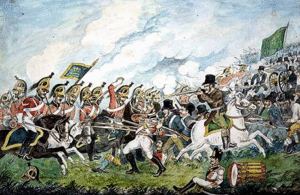
In 1798, a revolt started against British rule in Ireland. People hoped to create an independent Irish republic. The Society of United Irishmen started the rebellion. It was led by Theobald Wolfe Tone. Several things caused the revolt. These included Irish nationalism and news of the French Revolution's success. People were also angry about the British Penal laws. These laws treated Catholics and Presbyterians unfairly in Ireland. The rebellion failed. It led to the Act of Union in 1801. This act joined Ireland with Great Britain.
The Serbian Revolution (1804–1835)
The Serbian Revolution was a national uprising and a change in government in Serbia. It happened between 1804 and 1835. During this time, the area changed from an Ottoman province to a rebel territory. It then became a constitutional monarchy. Finally, it became the modern Serbian state. The first part of this period (1804 to 1815) was a violent fight for independence from the Ottoman Empire. There were three armed uprisings: The First Serbian Uprising, Hadži Prodan's rebellion, and the Second Serbian Uprising. This period ended with a ceasefire.
The later period (1815–1835) saw a peaceful growth of political power in Serbia. Serbia became more independent. This led to Serbian princes being recognized as hereditary rulers in 1830 and 1833. The country also grew in size. The first written Constitution was adopted in 1835. It ended feudalism (a system where land was owned by nobles) and serfdom (where people were tied to the land). It made Serbia a suzerain state, meaning it had some independence but was still under another power. The term "Serbian Revolution" was created by a German historian, Leopold von Ranke. He used it in his book Die Serbische Revolution, published in 1829. These events laid the foundation for the modern Principality of Serbia.
Experts have called the Serbian fight for independence a revolution. This is because the uprisings were started by many rural Serbian people. They had big disagreements with the Turkish landowners. These landowners were both political and economic masters. This was similar to the Greek War of Independence from 1821–1832.
The Latin American Wars of Independence (1808–1833)
Latin America had independence revolutions in the early 1800s. These separated the colonies from Spain and Portugal. They created many new nations. These movements were usually led by the Creole class. Creoles were people of Spanish background born in the Americas. They were often wealthy and held high positions. But they were still not as respected as Spaniards born in Europe. One important Creole leader was Simón Bolívar. He led several revolutions across South America. He helped create Gran Colombia. Another key figure was José de San Martín. He helped create the United Provinces of the Río de la Plata. He also became the first president of Peru.
The Greek War of Independence (1821–1832)
In the early 1800s, Greece was ruled by the Ottoman Empire. A series of revolts began in 1821, starting the conflict. The Ottoman Empire sent forces to stop the revolts. By 1827, soldiers from Russia, Great Britain, and France joined the fight. They helped the Greeks push the Turkish forces off the Peloponnese Peninsula. The Turks finally recognized Greece as a free nation in May 1832.
The Revolutions of 1820
The Revolutions of 1820 were a series of uprisings in Spain, Italy, Portugal, and Greece. Unlike the wars of 1830, these revolutions mostly happened in the outer parts of Europe.
The Revolutions of 1830
A wave of revolutions swept across Europe in 1830. This included two "romantic nationalist" revolutions. The Belgian Revolution happened in the United Kingdom of the Netherlands. The July Revolution took place in France. There were also revolutions in Congress Poland, various Italian states, Portugal, and Switzerland. Eighteen years later, an even stronger wave of revolutions followed. These are known as the Revolutions of 1848.
The Revolutions of 1848
The European Revolutions of 1848 are also known as the Spring of Nations. They were a series of political uprisings across Europe in 1848. This was the most widespread wave of revolutions in European history. However, within a year, the old powers had regained control. The revolutions then collapsed.
The political impact of the 1848 revolutions was clearer in Austria than in countries like Germany. This is because the uprisings in Vienna led to more deaths. They also gained stronger support from thinkers, students, and working-class people. Some accounts describe the German experience as less focused on national issues. But it did succeed in breaking down class barriers. People used to think there was only one revolution in Germany. However, newer studies show there were several revolutions happening at the same time.
The 1848 revolutions were also special because more women took part. Women rarely joined revolutionary activities before this. But some women played supporting roles. For example, a women's political club in Vienna demanded revolutionary changes. Parisian women protested and suggested their own solutions to social problems. They especially focused on their rights and crafts.
The Eureka Rebellion (1854)
The Eureka Rebellion was a short 20-minute fight. It happened between miners in Ballarat, Victoria, and the British Army. Miners were angry about the high cost of Gold Mining Licences. These licenses cost 30 shillings a month. So, the Ballarat miners held rallies at Bakery Hill. They burned their licenses and swore an oath under the flag of the Southern Cross. They chose Peter Lalor as their leader. They then built a stockade (a simple fort) around their digging area. British troops, led by Governor Charles Hotham, eventually fired on the stockade. The miners fired back. The fight lasted 20 minutes before British troops stormed their fort. Most miners were arrested by British authorities and put on trial. If found guilty, they could have been hanged for treason. But all of them were eventually found not guilty. The Eureka Rebellion is sometimes seen as the start of democracy in Australia. Many people interpret it as a political revolt.
The First War of Indian Independence (1857–1858)
The Indian Rebellion of 1857 was a major uprising in India. It happened from 1857 to 1858. It was against the rule of the British East India Company. This company acted like a ruler for the British Crown. The rebellion began on May 10, 1857. It started as a mutiny (revolt) by Indian soldiers (sepoys) in the Company's army. This happened in Meerut, about 40 miles (64 km) northeast of Delhi. The rebellion then spread. Other mutinies and civilian revolts happened mainly in the upper Gangetic plain and central India. Some incidents also occurred further north and east. The rebellion was a big threat to British power in that area. It was only stopped when the rebels were defeated in Gwalior on June 20, 1858. On November 1, 1858, the British offered forgiveness to all rebels not involved in murder. However, they did not officially declare the fighting over until July 8, 1859. This event has many names. It is called the Sepoy Mutiny, the Indian Mutiny, the Great Rebellion, the Revolt of 1857, the Indian Insurrection, and the First War of Independence.
The Bulgarian Revolts and Liberation (1869–1878)
Modern Bulgarian nationalism grew under Ottoman rule. This happened in the late 1700s and early 1800s. It was influenced by Western ideas like freedom and nationalism. These ideas came into the country after the French Revolution. In 1869, the Internal Revolutionary Organization was started. An independent Bulgarian Exarchate was set up in 1870/1872. This was for Bulgarian Orthodox Christians who wanted to join it. The April Uprising of 1876 indirectly led to Bulgaria becoming independent again in 1878.
See also
- List of revolutions and rebellions
- Atlantic Revolutions
- Modern history
- Long nineteenth century
- Pax Britannica
- Political history of the world
- Risorgimento
- Timeline of national independence
- Revolutionary Spring: Fighting for a New World 1848–1849 by Christopher Clark


